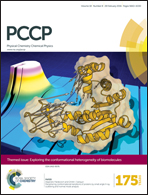High thermoelectric performance from optimization of hole-doped CuInTe2
Abstract
We investigated the electronic structure, lattice dynamics and thermoelectric transport properties of CuInTe2 based on first-principles calculations. From the analysis of density of states and partial charge density, it can be expected that p-doping at the In-site or n-doping at the Cu-site will barely modify the electronic states near the valence or conduction band edge but increase the carrier concentration to achieve the highest thermoelectric efficiency. Lattice dynamics calculations suggest that the thermal conductivity of CuInTe2 can be effectively reduced by introducing structural defects at Cu, In and Te sites. p-type CuInTe2 possesses better thermoelectric properties as compared to the n-type one, which mainly originates from the steeper density of states resulting from nearly degenerate valence bands near the band edge. The temperature dependence of the thermoelectric transport properties of p-type CuInTe2 at different carrier concentrations was studied in detail, which is found to be in good agreement with the experimental data. Our results of calculation showed that p-type CuInTe2 can achieve an upper-limit figure of merit value of 1.72 at 850 K and are promising thermoelectric materials for waste heat recovery at medium temperatures.


 Please wait while we load your content...
Please wait while we load your content...